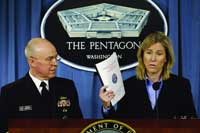The Defense Department's era of big networking programs seems to be succumbing to new budget pressures.Based on President Bush's fiscal 2008 budget request, experts predict funding and progress on programs such as the IT components of Future Combat Systems, the Warfighter Information Network-Tactical and the Joint Tactical Radio System will be hampered by DOD's more immediate need to fund the war on terror.'I think the big cuts in these systems-of-systems networking initiatives are probably a harbinger of things to come,' said Loren Thompson, chief operating officer of the Lexington Institute, a public-policy think tank based in Arlington, Va. 'First, [former secretary Donald] Rumsfeld is gone. Second, these programs don't deliver capabilities for years to come. And third, we need the money right now.'Overall, the Bush administration submitted a record-setting budget request for the Defense Department for 2008'$481.4 billion, 62 percent higher than the request for 2001, just seven years ago. DOD received an 11 percent increase over the 2007 request, the largest in the federal government.DOD comptroller Tina Jonas, at a Feb. 5 press briefing, broke down the budget request:Of the total budget, $31.4 billion, or 6.5 percent, is being allocated for IT expenditures. That's $650 million higher than the 2007 request, and soaks up about 48 percent of the entire federal budget for IT.This figure does not include any embedded IT projects, such as systems included in armaments, weapons, and communications programs in the research, de-velopment, test and evaluation budget.Examples of embedded systems requested include $2.8 billion for elements of the Army's FCS, $854 million for the Navy's JTRS project and $964 million for the Air Force's Transformational Satellite program.Those are lower than in previous years, Thompson said.The budget for FCS shows $3 billion in cuts over the next six years, while the date for the initial operating capacity for T-SAT shows a slip of at least a year, to 2016, he said. And Thompson questioned whether JTRS, which is intended as a battlefield communications system, will ever be deployed as it is currently planned.Another indication of change: DOD decided to end the Land Warrior program. After spending 10 years and $2 billion on developing network-centric capabilities all the way down to the individual soldier, the Army zeroed out funding in the 2008 budget and ended the program.Overall, the actual DOD request is even higher than $481 billion; the president submitted a second supplemental amount of $93.4 billion for 2007, and an 'emergency' $141.7 billion for 2008 to cover the cost of the wars in Iraq and Afghanistan. Including those, the DOD request actually totals $716.5 billion.The 2008 budget also provides funds for fielding more unmanned aerial vehicles, increasing the number of Predators to 170, and adds $310 million to deploy a missile defense site in Europe.In the budget, the Defense Information Systems Agency would get a big bump in its procurement budget, to $287 million, up 45 percent over the 2007 request, but its budget request for research, development, test and evaluation (RDT&E) drops to $366 million, down more than 12 percent from this year's request.Spending on the Defense Information System Network would jump sharply to $49 million, up 67 percent over the previous request, following DISA's award in October of a new, 10-year, $3 billion contract to upgrade DISN.Research and development on information security looms large, scattered through the budget as line item programs, both departmentwide and within individual agencies such as the National Security Agency, which is requesting $394 million for its information systems security program.'The military services have become increasingly concerned that their information systems could be compromised by enemy agents, by hackers or by other threats,' Thompson said. 'So they're putting quite a bit of money into information security and into system redundancy.'There are numerous joint programs geared to improving interoperability and communications with coalition partners. A new line item in the RDT&E budget, for instance, requests more than $26 million for 'joint/allied coalition information sharing,' and the Office of the Secretary of Defense is requesting another $16 million for the Joint Tactical Information Distribution System.In keeping with past practice, the request does not provide specific numbers for funding the intelligence community, but it 'supports improved sharing of intelligence information through the Information Sharing Environment, a governmentwide effort to share terrorist information among interested parties in federal, state and local governments,' the budget summary states.
Money: Navy Vice Adm. Steve Stanley and DOD comptroller Tina Jonas detail the budget request.
Cherie A. Thurlby
- Readiness and support, $146.5 billion, about 30 percent of the budget
- Strategic modernization, $176.8 billion, 37 percent
- Training, facilities and family housing, $21.1 billion, 4 percent
- Military pay and benefits including health care, $137 billion, 29 percent.







